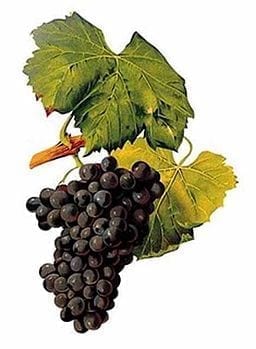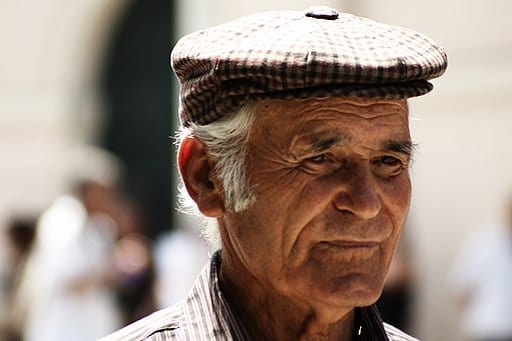Samuele Cannas
Pisa, Italy
 |
|
| Bunch of Cannonau Grapes Ampélographie Viala et Vermorel |
“O gentlemen, the time of life is short! / To spend that shortness basely were too long, / If life did ride upon a dial’s point, / Still ending at the arrival of an hour.”
– William Shakespeare, Henry IV, Part I, Act V, Scene 2
Humans have always pursued the search for immortality. It has been suggested that the maximum human lifespan is 125 years, even though the longest-living person was a French woman who lived “only” to 122. Surprisingly, just 20% of our longevity is determined by genetics, while the remaining part is deeply influenced by lifestyle, with a particular mention to diet.1 Recent findings indicate that lowered intake of particular nutrients and meal timing are crucial to ameliorate aging and aging-associated diseases in both model organisms and humans. A broad-spectrum and preventive medicine for promoting longevity is no longer utopian.2
The beneficial effects of healthy diets are exemplified by various long-living populations and Sardinians represent a striking example. Sardinia is a large island in the Mediterranean Sea, located 120 km from the Italian coast. In the third millennium BC it was inhabited by one of several groups of “sea peoples,” the so-called Sherden. They discovered a variety of wild red grapes, which they proceeded to cultivate, thus laying the foundations of Cannonau, the most important and representative Sardinian wine.3
Cannonau is also known as Cannonao in Sardinian, Garnacha in Spanish, or Grenache in French and occupies more than 4% of global area vineyards. For centuries it has been a controversial subject of dispute between Sardinia and Spain, as its origins were enshrouded in a thick and impenetrable mist. Specifically, Spain claimed to have exported the plant in 1400. In 2004, in Nuraghe Arrubiu, a prehistoric monument of the ancient Sardinian civilization, some Cannonau grape seeds were found and dated to the Sherden period. Furthermore, the name Garnacha itself refers to Sardinia. It has its roots from the noun Vernaccia, from the Latin word vernaculus, which means “indigenous, native.” Presumably, when ancient Romans conquered Sardinia, they did not know the difference between Cannonau, indicating only red wine grapes and Vernaccia, referring to white wine. Therefore, they called any grape varieties “vernaculus” and the name went down in history to indicate both white and red wine, with the exception of Sardinia, where the latter is rigorously known as Cannonau.4
Additionally, in Nuragic site “Sa Osa,” some mysterious archaeological finds were unearthed. Built in the Middle-Bronze Age, they were found to be primitive refrigerators. The holes, dug six feet deep into granitic rock, contained biological traces ranging from venison to grape seeds. Radiocarbon dating provided an objective age estimation of more than 5,000 years. This proved that the growing of wine grapes was a fundamental agricultural activity in Sardinia long before the Roman conquest. Amazingly, such seeds were genetically similar to modern cultivar of vitis vinicola, from which Vernaccia is obtained. Not only were the ancient Sardinians able to perform viticulture, but they were also particularly skilled at wine-making.
Historical and literary references unequivocally state that Garnacha referred to a Spanish white wine. The meaning of “dyed” (red) wine has been recorded since the eighteenth century, with the first transcript in a dictionary from 1734. The name Cannonau, however, was first used in an official document of the Sardinian lawyer Bernardino Coni in 1549, nearly two centuries before the Spanish denomination. In conclusion, Cannonau was born in Sardinia and subsequently spread to Spain and France.5
 |
| Sardinian man with traditional hat Su Bonette, Jean Bajean |
But what is the connection between a red wine and the secret to long life? In 2004 Dan Buettner, founder and CEO of Blue Zones LLC, teamed up with National Geographic and the National Institute of Aging to uncover the role of lifestyle and environment on longevity. Five geographical areas with the highest percentage of centenarians were found: Loma Linda (USA), Nicoya (Costa Rica), Ikaria (Greece), Okinawa (Japan), and Sardinia (Italy). Those regions were referred to as “blue zones,” where people reach the age of 100 at a ten times greater rate than the US average. Buettner noticed that all the areas, although distant in space and history, were characterized by nine evidence-based common peculiarities named the “Power 9.” These factors included: move naturally, i.e. moving spontaneously without thinking about it; purpose, an internal motivation to enjoy the intrinsic beauty of life; downshift, moments in which people shed all the stress stored up during the day; 80% rule, stop eating when stomach is 80% full; plant slant, beans, lentils are a cornerstone of such diet while meat is eaten only five times per month; belong, being part of some faith-based community; loved ones first, family is put in first position; right tribe, social circles supporting healthy behaviors, and finally, wine. Alcohol has to be consumed moderately and regularly, no more than one or two glasses per day, with friends and food. The preferable wine is Cannonau.6
Since Sardinia is home to the world’s longest-living men and Cannonau plays a fundamental role in their diet, the secrets of such a miraculous wine should be unravelled. In 2012, a group of scientists from Universities of Cagliari, Split, and Berger studied Cannonau’s composition by means of spectrophotometry, FRAP antioxidant power assay, and HPLC chromatography. The results were amazing. A group of heterogeneous molecules with antioxidant and artery-scrubbing properties were quantified to be three times higher than in other wines. Such substances, called “polyphenols” and ranging from simple phenols to flavonoids and xanthones, are endowed with powerful antioxidant activity, increased nitric oxide production, and protective effects against LDL oxidation and platelet aggregation.7 Furthermore, the Sardinian diet is extremely diverse and heterogeneous, varying from sheep and goat’s milk to a low-gluten and high-protein bread traditionally named carasau. Fava beans and chickpeas are frequently eaten as well as Marian thistle. However, goat and pork are also a typical dish of this local cuisine, with a high concentration of saturated fats, a known predisposing risk factor for cardiovascular diseases. But paradoxically, Sardinians have a low incidence of cardiovascular disorders. This phenomenon has also been observed in France and was named the “French Paradox.” There are different interpretations, but it seems the main factor responsible for this paradoxical circumstance is the moderate consumption of red wine, typical of France and Sardinia.8
Science has always sought better answers to the most authentic and ancestral imperative to avoid preventable deaths. Indeed, death is intrinsically bound to the concept of humanity itself and cannot be escaped. However, it may be postponed and diet represents an important factor in this respect. Specifically, Cannonau seems to be an invaluable contributor to longevity by its unique properties and noble peculiarities. As Shakespeare wrote, the time of life is short. Nonetheless, the shortness of life petrifies and gives way to the inviolable power of a glass of Cannonau. Cheers!
References
- Buettner D, Skemp S. Blue Zones: Lessons From the World’s Longest Lived. Am J Lifestyle Med. 2016;10(5):318-321. doi:10.1177/1559827616637066
- Fontana L, Partridge L. Promoting Health and Longevity through Diet: from Model Organisms to Humans. Cell. 2015;161(1):106-118. doi:10.1016/j.cell.2015.02.020
- Emanuel JP. Sea Peoples , Egypt , and the Aegean : The Transference of Maritime Technology in the Late Bronze – Early Iron Transition ( LH IIIB – C ). Aegean Stud. 2014;1:21-56. http://www.aegeussociety.org/en/index.php/aegean-studies/emanuel-sea-peoples/%5Cnhttp://extras.ha.uth.gr/darkagesrevisited/el/index.asp%5Cnhttp://extras.ha.uth.gr/darkagesrevisited/el/paper.asp?paper=45.
- Tuberoso CIG, Boban M, Bifulco E, Budimir D, Pirisi FM. Antioxidant capacity and vasodilatory properties of Mediterranean food: The case of Cannonau wine, myrtle berries liqueur and strawberry-tree honey. Food Chem. 2013;140(4):686-691. doi:https://doi.org/10.1016/j.foodchem.2012.09.071
- Di Loreto S. Dove è nato il Cannonau o Grenache o Garnacha? http://www.coppiere.it/2015/02/dove-nato-cannonau-grenache-garnacha/. Published 2015.
- Buettner D. The Blue Zones Solution: Eating and Living Like the World’s Healthiest People. Washington, DC: National Geographic Society; 2015.
- Nadtochiy SM, Redman EK. Mediterranean diet and cardioprotection: The role of nitrite, polyunsaturated fatty acids, and polyphenols. Nutrition. 2011;27(7):733-744. doi:https://doi.org/10.1016/j.nut.2010.12.006
- Ferrières J. The French paradox: lessons for other countries. Heart. 2004;90(1):107 LP-111. http://heart.bmj.com/content/90/1/107.abstract.
SAMUELE CANNAS attends the 4th year of Medicine at both Sant’Anna School (SSSUP) and University of Pisa where he is pursuing additional degree courses in biomedical engineering and biotechnology. He has a heartfelt passion for music and graduated with distinction from Cagliari’s Music Conservatory in Piano in 2017. Samuele is successfully advancing both his academic and musical interests, performing in concert and conducting research on surgery, robotics, and bioethics. In 2015, he was appointed ensign of the Italian Republic for his academic achievements, which have been recognized by multiple awards.

Leave a Reply